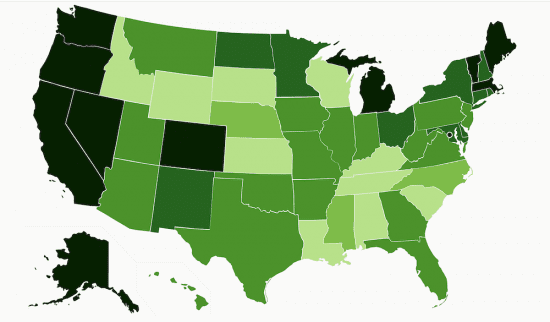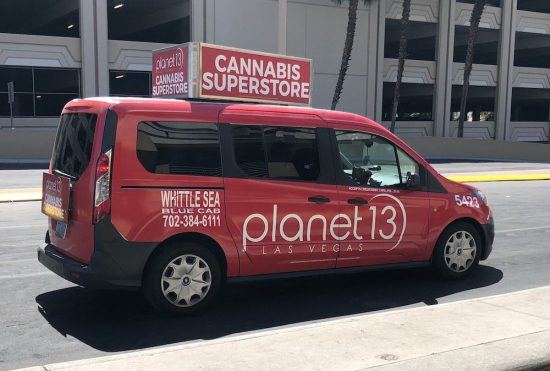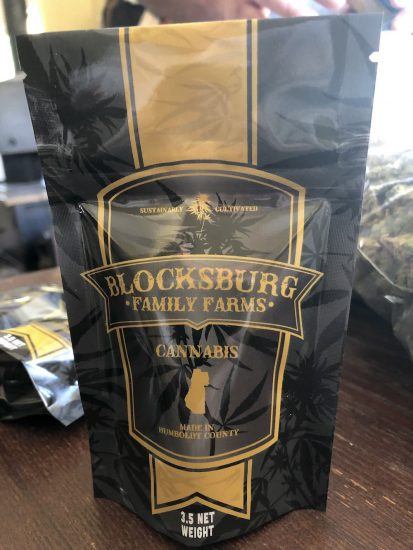Yesterday, the Adam Smith think tank recommended the legalization of cannabis in the UK [Evening Standard article]. Based on their research and the examples of Canada and Colorado in the US, the evidence seems to point to pot legalization leading to lower crime. Personally, I’m in favor. But, let’s look at the state of the business and what the future holds for the cannabis industry.
Burgeoning disruption
I have been working on disruption and transformation for 10 years, ever since I left my ‘regular’ job at L’Oréal. Over the years, I have considered that the most disrupted industries — or at least those that were most on the front line with the arrival of the Internet — were media, (music, video, news…), spying and porn. Of course, the reality is that pretty much every industry has been upended and has to toil through waves of disruption. But, I recently plunged into the wild and nascent cannabis industry in the US, with a visit to the hallowed land of Southern Humboldt (in Northern California) as well as a short trip to Las Vegas. And, in between all the hyperbole, I’m now inclined to say that the cannabis industry may actually be the most disrupted industry… of all. Talk about an industry going to pot!

Just like any incumbent industry being disrupted, there are many new players who are coming in. The impetus for the new entrants, in the case of cannabis, is a change in legislation (state legalization & licenses…) in North America. The drug is now legal in 11 states in the US (and across Canada).


As the map shows, the lay of the land is very varied! The key under the map helps to decode the state of legalization of cannabis in the US. In Canada, recreational pot has been legal nationally since October 2018. N.B. Medical marijuana has been legal in Canada since 2001. Clearly, there’s been a land swell around the beneficial medicinal properties for a large number of pathologies (including depression, PTSD, pain relief, glaucoma, post stroke…), though there’s bound to be more research and controversy as we build and work through the data. [See LifeHack]

There has been an explosion in terms of offer: straight weed with different strains and hundreds of brand names, pre-rolled joints, edibles, vape pens, drinks… Then there’s the digital landscape which is essentially the ONLY playground (other than on taxis it seems) for cannabis companies to communicate on their business or brand. Finally, the entire business model has been completely upended for the old-time farmers who are the original incumbents, aka “the elders.” And the incumbents are all asking themselves: who moved my weed? Whereas they spent many decades growing cannabis illicitly, now the farmers are having to move to a legitimate business, along with developing brands and mastering the new forms of digital marketing. And the road ahead looks paved with some unsure stone(r)s, especially for those businesses that deal with the cannabis plant.
The future of the cannabis industry
It’s hard to predict how big the industry will get, but revenues in 2018 were above expectations in most places. For example, cannabis sales in Colorado exceeded $1 billion, bringing in $266 million in revenues to the government through fees, licenses and taxes {source: Colorado.gov}. Despite these results, the nascent industry is still clearly trying to find its feet and it feels a bit like the wild west. There are now quite serious retailers who have staked their claim in the legal states and ‘cannabis marketing’ is becoming a thing. However, the retail experience I had at a MedMen dispensary in Las Vegas was 4 parts novelty, 1 part a reasonable customer experience, starting with the laborious ID check and registration at the door. There are also now some decent informational sites (e.g. Leafly, The Cannabis Marketing Association) and podcasts (e.g. CannaInsider) that are discussing and debating the ins and out of the industry. There are now many ‘green’ diggers on Wall Street who are seeking out new high flying investments in the cannabis industry. To wit, the numerous new cannabis funds.
But, it’s still considered a risky business. And for now, there seem to be a number of broken parts of the chain in the US:
- Cannabis is still not legal federally in the US (much less the rest of the world) which means that laws are fractured and vary city to city and state to state.
- The opposition to cannabis is still quite virulent, especially in the middle of the US: who’ll win out?
- We’re still differentiating between medical and recreational product in distribution.
- There is evidently much distrust within the players in the industry. How will the trust between old-time farmers, distributors, dispensaries and law enforcement evolve?
- To what extent will the government look at taxation and regulation as a mechanism to annihilate the industry (à la tobacco)?
- There is no standard of governance in terms of quality, marketing & advertising, safety and legitimacy.
Uncanny-bis questions to be answered
The cannabis industry is in turmoil and experiencing a unique turbulence. It will have a relatively short window through which to find its way. There are a huge number of unknowns and variables, as well as many extraordinary opportunities for the more daring investors. Here are the questions that I believe will need to be answered to broaden the legitimacy of this market:
- When/if medical marijuana will gain legitimacy in the broader medical community?
- Will recreational marijuana ever gain the same acceptance as alcohol? For example, will consumption ever be allowed in bars or outside of home (cf Las Vegas where you can only smoke at home)?
- How will CBD (the non-intoxicating and therapeutic cannabidiol) and THC (the active ingredient in cannabis that gets you high) mature together?
- How will the economic model (and pricing) accept the notion of craft marijuana? For example, how will accounting principles and profitability evolve for the farmer?
- How will the distribution model evolve? For example, how/if retail stores (“dispensaries”) will survive/thrive in the face of direct delivery?
- How will consumers evolve in their acceptance and consumption of cannabis?
- What narrative will the media provide?
- And finally, when will cannabis be legalized nationally and internationally?
- …
How should the cannabis farmers deal with the new world order?
The first and most important point is that there are no hard and fast rules that will guarantee success. Surely, finding a way to educate all the different stakeholders (and consumers) will be vital and will likely take a long time. In the wine industry, for example, they’re still trying to figure how best to educate the consumer. Meanwhile, I think there are five guiding principles that I suggest cannabis farmers, especially those transitioning from the black to the “white” (i.e. legal) market, need to consider.

- Why are you in the business? If you have a ‘why’ that is bigger than just growing great grass or making dough, you will find the resources to better overcome the obstacles. That why, which will be different for each farmer, will help you to tap into your discretionary energy.
- Tap into your history. Each farmer has an original and different story. This should be the basis of your unique brand. This will be your only protection from the big guys (e.g. RJR Nabisco, Philip Morris…) when they enter the market.
- What do you stand for? Each farmer needs to establish their most important and singular values.
- Make sure your product is either different, unique and/or reliably superior, if not the best.
- Create a congruent and value-added brand that shows your product in an individual and distinct manner. A key part of making your brand come alive will include finding the right partners with shared values and vision.
How should the original cannabis farmers react, act and succeed? It’ll be awfully interesting to see how this new wild world develops. In the end of the day, many of the principles of die, survive or thrive are similar for other businesses and industries. Much of the transformation resides in the mindset! Just hope the mind isn’t too blown to deal!











As usual, Minter gets to the heart of disruptive industry with the highest level analysis of how such forces need to interact with us in order to become successful. If cannabis is to become the positive, sustainable, and acceptable product it’s providers say it is, everybody involved in this movement will be wise to pay more than token attention to Minter’s articulation of how to get there.
Thanks Brad for chiming in. It will indeed take a widespread (dare I say ‘joint’) effort to make sure that the cannabis movement works… One of the keys will certainly be educating the public (and media) on how to consume responsibly. When the NYT and the networks, not just High Times, talk about the different forms and how to consume appropriately, we’ll have made progress.
The issue of cannabis legalization is pretty weird. As a spectator of the phenomenon in California, it is obvious that many questions remain unanswered today : should we release and compensate any person arrested to a crime related to cannabis before it was legalized? Can we drive under the influence ? To what extent is an insurance company covering health issues related to cannabis ? Where can I legally smoke ? Should the law regard people under the influence of only CBD differently then people under the influence of full-blown THC? … It’s funny how all those questions and many more remain taboo here in California. The legalization is obviously a massive economic trend, but the societal impact of it is still very fuzzy…
You are so right Xavier. Many questions and doubts remain in society… With various factions continuing to highlight the risk of cannabis as a gateway drug. We are from having a protocol as we do for alcohol. But I would suggest that the alcohol laws in the US (eg over 21 years old) are rather outdated too. The heterogeneity of the state laws make it all very confusing. Imagine driving where all laws changed when you cross state lines! As someone who consumed pot when it was illegal, even that statement in print here feels awkward.